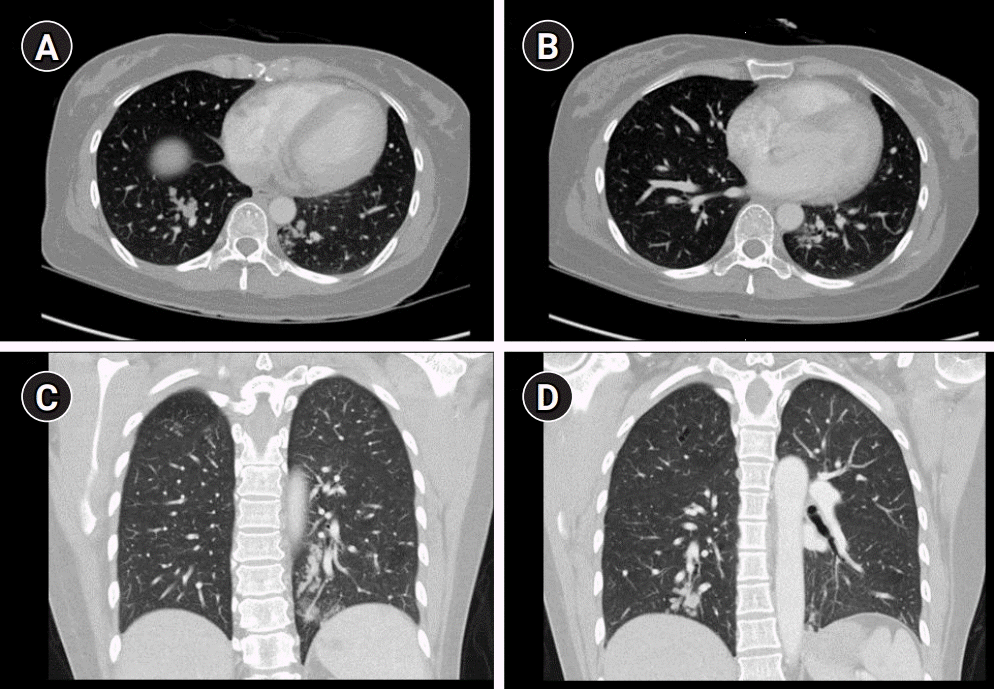Choriocarcinoma is a very aggressive, malignant variant of GTD, which grows rapidly and metastasizes to the lung, liver, and, less frequently, to the brain. The metastatic involvement of the lung in our case suggested that the clinical pathologic form of this patient was choriocarcinoma. Most cases of choriocarcinoma involving the CNS present with both intra- and extra-axial hemorrhage. These were manifested by vascular fragility and rupture of oncotic aneurysms. Arterial infarctions due to direct tumor emboli are also possible, but there was no evidence of vascular tumor invasion on serial contrast-enhanced MRI [
2]. If the ratio of serum to CSF hCG is less than 60, CNS metastasis is strongly suspected. Unfortunately, we performed CSF analysis two weeks after chemotherapy because increased intracranial pressure was assumed during the period of acute ICH, IVH, and SAH. The ratio of serum to CSF hCG could not be obtained [
3]. Acute cerebral infarctions in multiple vascular territories and elevated level of D-dimer (1.61 µg/mL) were observed in this case. These findings suggest that the main cause of multiple cerebral infarctions and hemorrhage could be cancer-associated hypercoagulability rather than direct tumor emboli. A previous study showed that concealed cancer should be considered in patients with ischemic lesions in multiple vascular territories on diffusion-weighted imaging (DWI). The level of D-dimer, a specific derivative of cross-linked fibrin, has been used in many previous studies as a measure of hypercoagulability [
4]. The DWI pattern of ischemic lesions in multiple vascular territories and elevated D-dimer level (>1.11 µg/mL) was independently associated with cancer-related coagulopathy (CRC) [
5,
6]. In these scenarios, ICH could occur in the preexisting infarct area. There have been a few case reports of metastatic choriocarcinoma as a cause of ischemic and hemorrhagic stroke [
7-
9]. The case reported by Bonnet et al. [
7] was very similar to our case in terms of the concomitant presence of multiple ischemic stroke and lobar hematoma. In this case, a local thrombus in the left atrium was detected on transesophageal echocardiography (TEE). It could be considered that thrombotic embolus was the most plausible diagnosis. However, there was no evidence of hypercoagulability in her laboratory findings [
7]. Another case had multiple distributed, small, and large infarctions. Her neurological state deteriorated 3 days later. Hemorrhagic transformation of the large infarction in the left MCA territory was observed [
9]. The precise pathogenesis of multiple small and large infarctions remained uncertain. In our case, D-dimer levels were elevated, suggesting hypercoagulability. Although we could not perform TEE, there was no evidence of non-bacterial thrombotic endocarditis on TTE. Several cases of choriocarcinoma with pulmonary thromboembolism have been reported previously [
10]. The effects of thrombolytic therapy, embolectomy, and/or anticoagulant therapy were uncertain in these cases. The literature highlights the importance of early diagnosis and timely appropriate chemotherapy in the management of this condition [
10]. In our case, the patient was diagnosed with PTTM. The pathomechanism of PTTM involves tumor cells entering the pulmonary circulation; this occludes small arterioles and expresses vascular endothelial growth factor and tissue factor that lead to proliferation of intimal myofibroblasts and luminal stenosis. The coexistence of the PTTM and stroke suggested that the pathomechanisms of these were similar [
11]. The arterial tumor emboli could have occurred when the metastatic pulmonary neoplasm invaded the heart through the pulmonary vein. Although there was no evidence of brain metastasis on the serial contrast-enhanced MRI and CSF analysis, there were possibilities of micro-thromboembolism, micrometastasis, or micro-tumor embolism, which cannot be detected on MRI. Choriocarcinoma may metastasize to the cerebral blood vessels, resulting in ischemic stroke or intraparenchymal hemorrhage [
8,
12]. Furthermore, the coexistence of micro-tumor embolism with CRC could not be excluded in our case. The ratio of serum to CSF hCG before chemotherapy may be important to confirm CNS metastasis. However, we checked the CSF after the initiation of chemotherapy because of the presence of increased intracranial pressure. Timely appropriate chemotherapy was very important in this condition.
This is a rare case of multiple embolic infarctions and intracranial hemorrhages in a patient with GTD. The precise pathogenesis of coexisting ischemic and hemorrhagic strokes is not clear. CRC, micro-tumor emboli, or both could be the pathogenesis of this rare presentation.





 PDF
PDF Citation
Citation Print
Print




 XML Download
XML Download